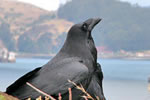
Description |
The turkey vulture is a large bird (about 28 inches in length), mostly dark gray, black, or brown, with a featherless reddish head (gray in immatures), and small, white bill. They are most often seen soaring above farmlands, open woodlands, or highways, in the characteristic “V” shape. The turkey vulture has a wingspan of up to six feet in length and shows silvery, gray outer wing feathers in contrast to its dark body, shoulders, and tail. Turkey vultures are graceful fliers and often ride thermals for hours without flapping. |
Diet |
| Turkey vultures travel great distances in search of carrion. They use their powerful sense of smell to locate dead animals. The part of the brain responsible for smell is particularly large in the turkey vulture compared to other animals. |
Range/Habitat |
| Turkey vultures are found throughout most of North and South America. They are most often found in open or semi-open areas, but will turn up virtually anywhere there is carrion. Some birds will migrate from northern locales during the fall. turkey vultures are often observed in the early morning roosting on a communal perch such as a dead tree or electrical tower. |
Nesting |
| The nest site of the turkey vulture is usually hidden away on a cliff, cave, thicket, or abandoned farmhouse or building. Adult birds do not actually build a nest. The female lays two eggs that hatch after about 40 days. Both parents incubate the young and feed them regurgitated food. |
Status |
| Turkey vultures are common. |
 |
 |
 |
 |
 |
 |
 |
 |
 |
 |
 |
 |
 |
 |
 |